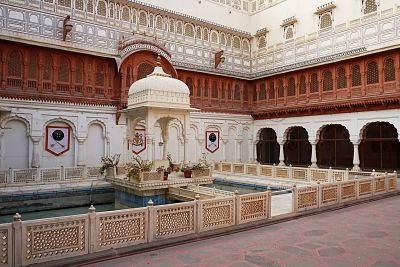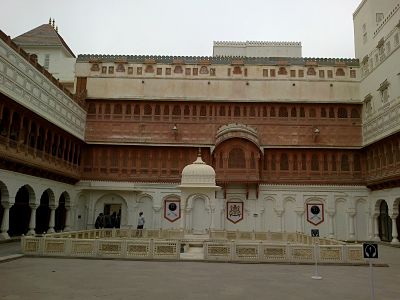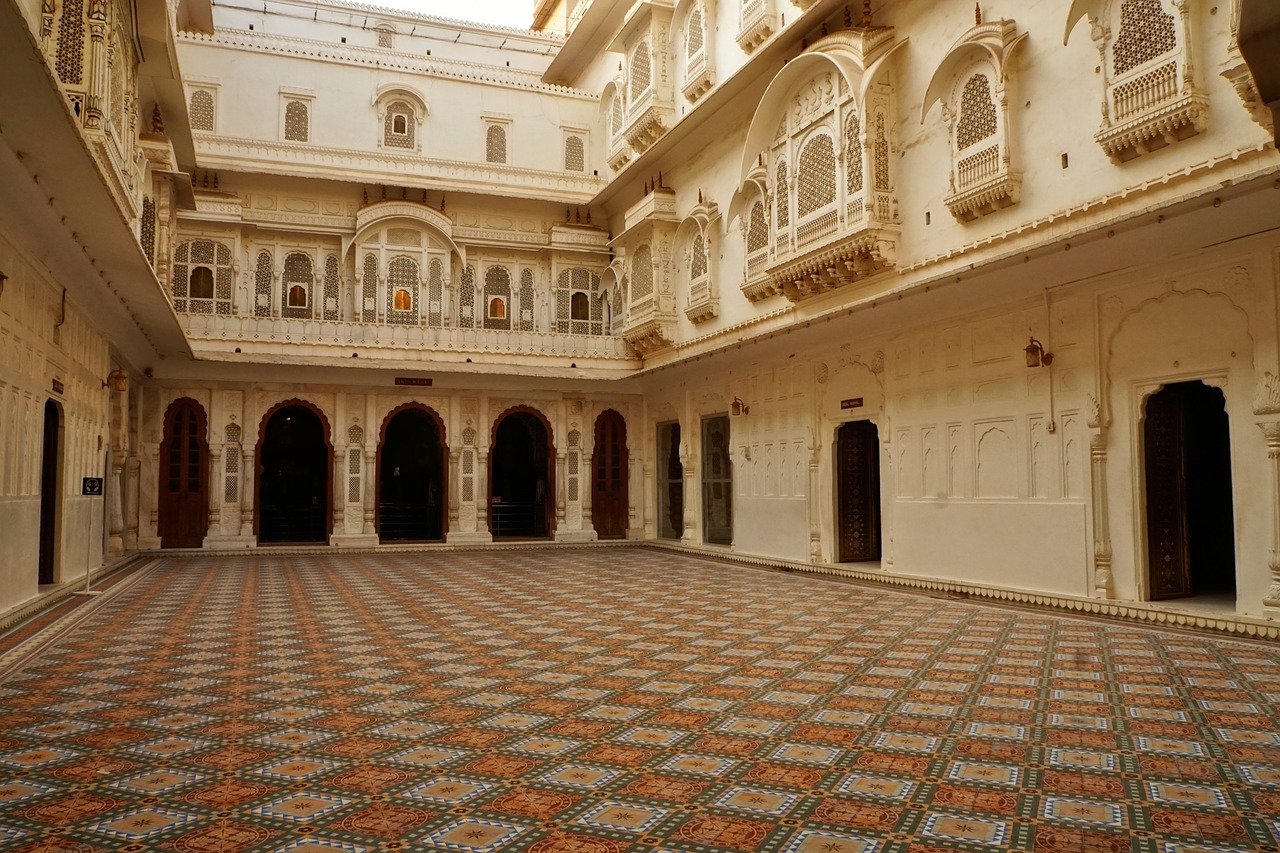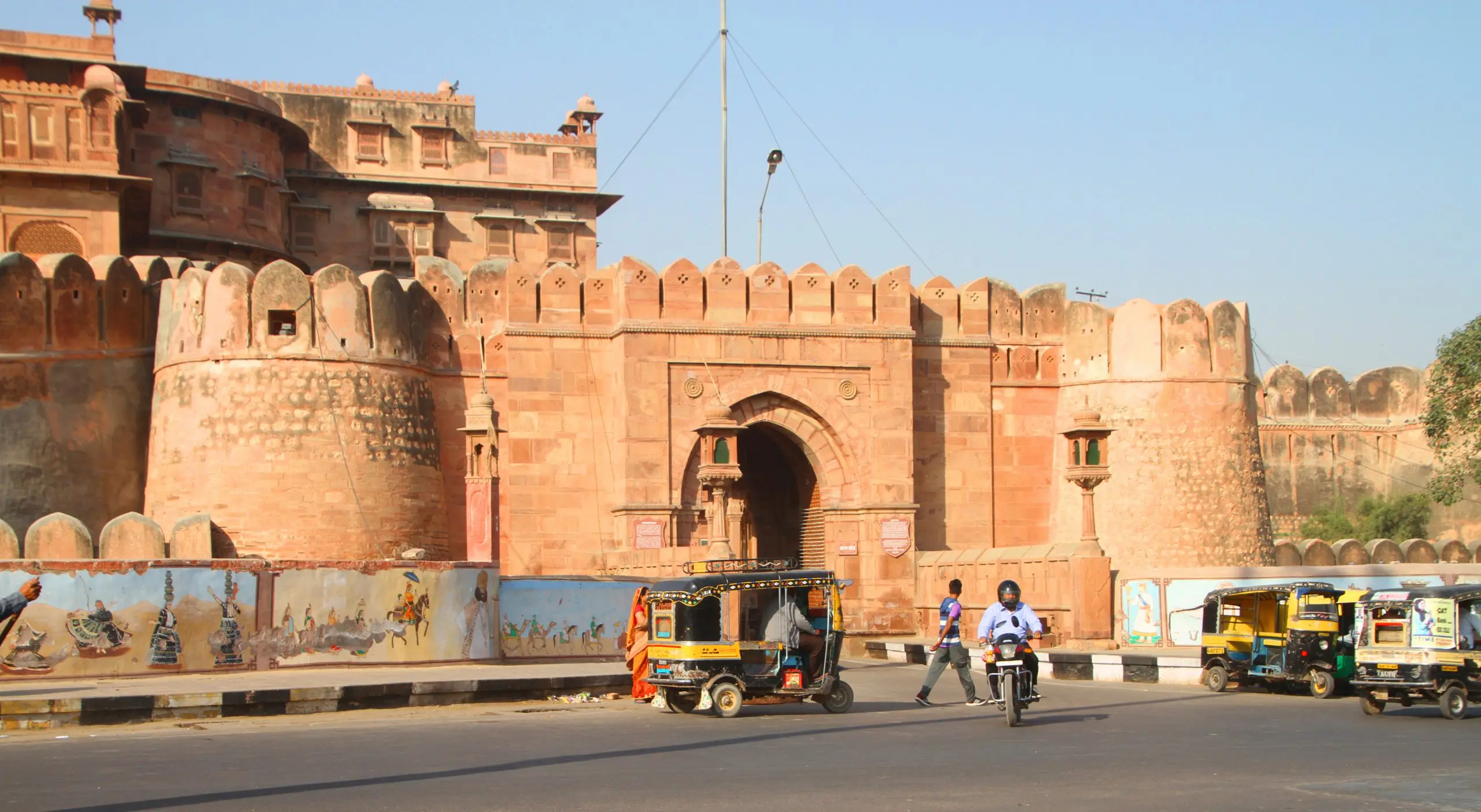Located in Bikaner, Rajasthan the Junagarh Fort is one of the most important tourist destinations in Rajasthan. The fort of Junagadh is also known as the Bikaner fort. Junagarh Fort is not built at the height of the mountain like other Rajasthan forts. The present Bikaner city has developed around the Junagarh fort.
The fort of Junagarh Bikaner is famous for its monument fort, history, architecture, culture, and photography.
Junagarh Fort Bikaner Rajasthan
Junagarh Fort is actually known as Chintamani Fort and Bikaner Fort and was renamed Junagadh in the early 20th century as the family residing in the fort shifted to Lalgarh Palace in the 20th century.
The Junagarh fort was constructed under the supervision of Prime Minister Karan Chand of Bikaner ruler Raja Rai Singh, Raja Rai Singh ruled Bikaner between 1571 and 1611 AD.
History of Junagarh Fort Bikaner
The construction of the Junagarh fort walls and moat began in 1589 and was completed in 1594. They have been built outside the original fort of the city, these walls and trenches were constructed at a distance of 1.5 km from the city center. The remaining part of the Junagadh Fort is built around the Lakshmi Narayan Temple.
According to historical documents, Junagarh Fort was attacked many times by enemies, but no one could ever get it, only Kamran Mirza kept it under his control for a day.
5.28 A palace, temple, and theater are built in the complex of the fort of Acker. These buildings reflect the mixed architectural art of the time. Kamran was the second son of the Mughal emperor Babur who invaded Bikaner in 1534, and after this Bikaner was ruled by Rao Jit Singh.
The ancient city of Junagadh is named after an old fort. It is located near Girnar mountain. The sites of the pre-Harappan period have been excavated here. The city was built in the ninth century.
It was the capital of the Chudasama Rajputs. It was a princely state. On the way to Girnar is dark basalt rock, inscribed representing three dynasties.
The Mauryan rulers Ashoka (circa 260–238 BCE) Rudradaman (150 AD) and Skandagupta (circa 455–467). There is also a stupa with caves made by Buddhists during 100–700 AD. Several temples and mosques located near the city reveal its long and complex history.
Here in the third century BC Buddhist caves, Emperor Ashoka’s mandate engraved on stone, and Jain temples are located somewhere on the peaks of Girnar mountain. Junagadh, the fortress of Rajputs until the 15th century was captured in 1472 by Mahmud Begha of Gujarat, who named it Mustafabad and built a mosque here, which is now in ruins.
Junagarh Fort still proudly narrates its history and says that no ruler has ever defeated me. It is said that only once in history, there is mention of an attempt by a non-ruler to capture this grand fort.
Bikaner Fort Rajasthan
Mughal ruler Kamran is said to have succeeded in seizing the throne of Junagadh and conquering the fort, but he had to leave the throne within 24 hours. Apart from this, there is no mention that Junagadh had any intention of defeating any ruler and he was successful.
Deserting Rajasthan in the rainy season, especially in the old era when it was a festival for the rainy Rajasthan, during that time, the King-Maharaja used to realize the rain by building a Badal Mahal in the royal fort of the state.
Badal Mahal built in many forts including Jaipur, Nagaur forts are examples of this, but the Junagadh fort of Bikaner is very popular for the specially built Badal Mahal.
This magnificent palace built at a very high altitude in the Junagadh fort complex is called Badal Mahal because it is situated at the highest height in the fort.

Upon reaching the palace, it really feels like you have come to a cloud of the sky. The walls adorned with blue clouds give a feel of the showers of Barkha. The fresh air flowing here touches all the tiredness of the tourists.
History is associated with this entire Junagarh Fort to very deep roots, so the tourists are very attracted to it. This fort is entirely made of red sandstone of the Thar Desert. However, marble work has been done within it. There are many wonderful things to see in this fort. Here the king has a rich heritage with many Havelis and many temples.
Some of the palaces here include Ganga Mahal, Phool Mahal, etc. including ‘Badal Mahal’. There is also a museum in this fort which also has clothes, paintings, and weapons of historical importance. This museum is one of the special attractions of Rajasthan for tourists.
Here you will also find many manuscripts written in Sanskrit and Persian. The museum inside the Junagadh Fort is the biggest attraction for tourists in Bikaner and Rajasthan. This fort museum has some very rare paintings, jewelry, weapons, biplanes, etc. of the First World War.
According to historians, the foundations of the finds of this fort were laid on Thursday, 30 January 1589. Its foundation stone was laid on 17 February 1589.
Its construction was completed on Thursday 17 January 1594. Architectural, archaeological, and historically significant, the Turkish style was adopted in the construction of this fort in which the walls are tilted inwards. Palaces in Delhi, Agra, and Lahore are also reflected in the palace built in the fort.
The fort is in a quadrangular shape, built in a circumference of 1078 yards, and has 37 bastions on average 40 feet in height, surrounded by walls from all sides. This fort has 2 entrances – Karan Prowl and Moon Prowl. Karan Pral is made in the east direction with 4 gates and Chand Pral is made in the west direction, which is the only gate protected by Dhruva Pral.
All the proles are named after the principal rulers and princes of the royal family of Bikaner. Many of these proles are such that preserve the fort. In olden times, no war was considered to have been won until the fort was conquered there.
Enemies had to cross a deep moat, then cross strong walls, then proles had to be captured to enter the fort. The doors of the proles are made of the very heavy and strong wood. It has solid iron speckled nails.

Anup Mahal is a multi-story building, which used to be the headquarters of the empire in history. Its ceiling is made of wood and glass, as well as Italian tiles and lattice windows and balconies were used in its construction. Some artifacts have also been made in this palace with gold leaves. It is also considered a huge construction. Junagadh Fort and Bikaner’s Palace-
Phool Mahal is the oldest part of the fort which was built by Raja Rai Singh of Bikaner, who ruled from 1571 to 1668.
The Ganga Mahal was built in the 20th century by Ganga Singh, who ruled for 56 years from 1887 to 1943, the fort has a huge Durbar Hall, also known as Ganga Singh Hall.
Bikaneri Haveli is a beautiful example of Bikaner’s special and famous architecture, both inside and outside the city of Bikaner. Aldous Huxley, a foreign tourist who visited Bikaner, said, “These Havelis are the pride of Bikaner”.
Karan Mahal (Public Audience Hall) was built by Karan Singh in 1680 C. It was built in the victory of the Mughal Emperor Aurangzeb. A garden has also been constructed near this palace and it is included in the famous and huge kilo of Rajasthan. This fort reflects the historical architecture of Rajasthan.
The windows of the fort are made of colored glass and the intricately painted balconies have been made of wood. Later, Rajas, Anup Singh, and Surat Singh also repaired the palace, made it shiny, got the glass, and also painted red and golden paint.
Badal Mahal is a part of the existence of Anup Mahal. It has a painting of Shekhawati Dundlod, who is paying respects to the Maharaja of Bikaner in a different turban. It also has photographs of people standing on nails, wood, swords, and saws. On the walls of the palace, there are also pictures of Hindu God Shri Krishna. The throne room also has a strong niche that is used as a throne.
Chandra Mahal is the most magnificent and magnificent room of the fort, there are artifacts and paintings of deities made of gold, in which precious gems are also studded. In this royal bedroom, the glass is placed in such a way that the king can see whoever is entering his room as he sits on his bed.
Maharaja Rai Singh Trust was built by the royal family of Bikaner. So that more and more information about the history of the fort can be conveyed to the tourists. Along with this, the main objective of establishing this trust was to develop education, culture, and people in the state.
The Fort museum built within the fort is named Junagadh Fort Museum, which was established in 1961 by Maharaja Dr. Karni Singh under the control of “Maharaja Rai Singh Trust”.

The museum exhibits Persian and Manusmriti, historical paintings, jewelry, royal costumes, royal decrees, galleries, customs, and statues of the supposed Lord. The museum also has an armory in which memories of past wars have been decorated.
Visiting Time Bikaner Fort Rajasthan
10.00 Am t0 4.30 PM
Enter fee Junagarh fort Bikaner
50 INR Indian 300 INR foreigner
How to reach Junagarh Fort Bikaner
Near Railway Station Bikaner Jn 3KM
Near Airport Nal Bikaner 20KM

My self Dev Satish. I’m an Author and Founder of tourism-rajasthan.com. I’m from Rajasthan and If I talk about my Education then I’m Law Graduate. I love doing work that makes me happy, that’s why I love traveling. you will find Rajasthan travel ideas & tips on this blog.

Very informative
Last year i visit rajastha. ..i was really amazing
Wow. The fort is so beautiful. Lucky are the people who stay in the same city rich with beautiful fort.
Very beautiful place and
Amazing write up keep it up
Nice your post………..
are pets allowed inside the fort/palace complexes? there is no clarity on rajasthan toursim website or any other portal. thanks in advance.